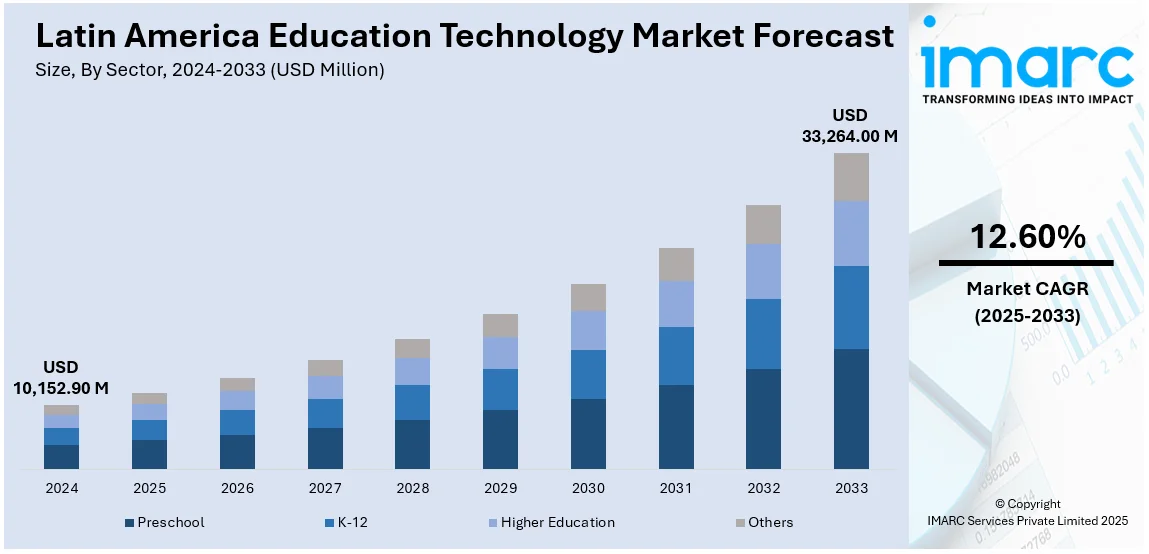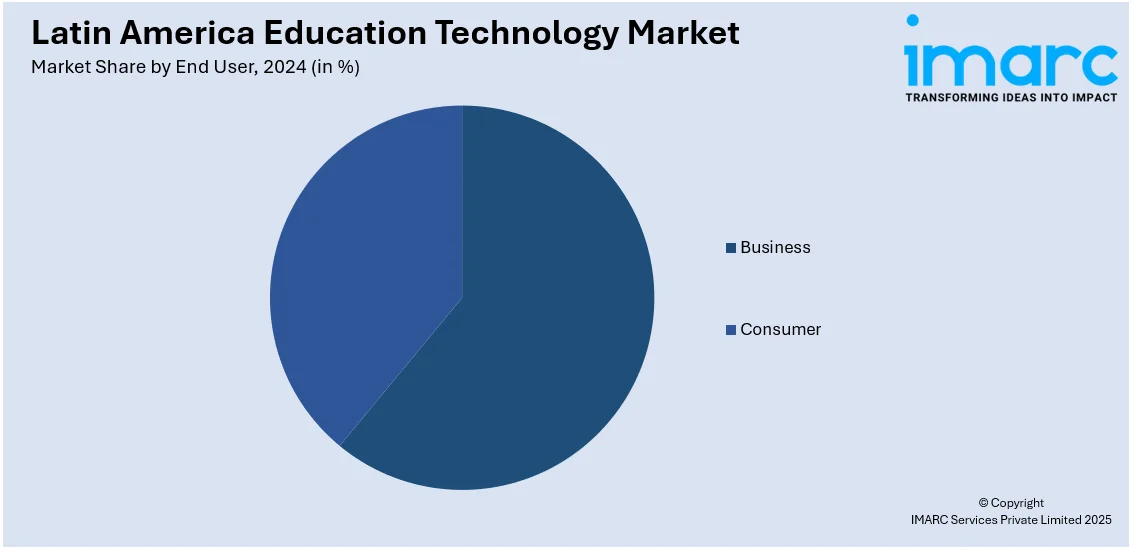
Latin America Education Technology Market Size, Share, Trends and Forecast by Sector, End User, Type, Deployment, and Region, 2025-2033
Latin America Education Technology Market Overview:
The Latin America education technology market size reached USD 10,152.90 Million in 2024. Looking forward, IMARC Group expects the market to reach USD 33,264.00 Million by 2033, exhibiting a growth rate (CAGR) of 12.60% during 2025-2033. Increased internet penetration, rising demand for remote learning solutions, government investments in digital infrastructure, personalized learning experiences, and the integration of advanced technologies like artificial intelligence (AI) and data analytics are some of the key factors influencing the market growth.
|
Report Attribute
|
Key Statistics
|
|---|---|
|
Base Year
|
2024 |
|
Forecast Years
|
2025-2033
|
|
Historical Years
|
2019-2024
|
| Market Size in 2024 | USD 10,152.90 Million |
| Market Forecast in 2033 | USD 33,264.00 Million |
| Market Growth Rate (2025-2033) | 12.60% |
Latin America Education Technology Market Trends:
Rising demand for remote and hybrid learning solutions
One of the main factors propelling market growth is the increased adoption of remote and hybrid learning across Latin America highlighting the demand for flexible educational solutions. Disruptions to traditional classroom environments prompted educational institutions to swiftly embrace technology to maintain learning continuity. For instance, in December 2024, UNESCO IESALC announced its plans to soft launch a pivotal report analyzing digital transformation in higher education across Latin America and the Caribbean. The findings reveal significant disparities and innovations sparked by the COVID-19 pandemic aiming to foster dialogue on integrating recommendations into regional policies and practices for inclusive education. This transition has resulted in a heightened need for platforms that support online classes, collaboration and engagement. Schools, universities and corporate training programs are increasingly adopting learning management systems (LMS), virtual classrooms and interactive educational tools. The emphasis on hybrid learning models combining in-person and online instruction is driving investments in technology that enhance teaching and learning experiences ensuring that education is accessible to all students regardless of location thereby strengthening the market growth.

Increasing government support and investment
Governments across Latin America are recognizing the importance of education technology in improving learning outcomes and addressing disparities in access to quality education. As part of their educational reforms several countries are allocating funds to develop digital infrastructure, provide devices for students and integrate technology into curricula. Initiatives aimed at training educators in the effective use of technology are also gaining momentum. Countries like Brazil, Mexico and Colombia have launched programs to enhance digital literacy among teachers and students. For instance, in August 2024, the Mexican Ministry of Economy and Kyndryl announced their partnership to launch a Digital Education program aimed at empowering MSMEs, women, youth and indigenous communities. The initiative includes free workshops and virtual training to enhance digital skills promoting sustainable economic growth and reducing the digital divide across the country. This government support not only fosters innovation but also encourages private-sector investment creating a positive outlook for market expansion.
Personalized learning experiences through data analytics
Another trend influencing the Latin American education technology industry is the increased emphasis on individualized learning. With significant advancements in data analytics and AI educational platforms may now adapt learning experiences to individual students' requirements. These technologies allow instructors to provide personalized curriculum, evaluations and feedback by assessing performance data, learning habits and preferences. This personalized approach improves student engagement, motivation and learning results. As a result, many educational institutions are implementing adaptive learning technologies which modify the pace and style of instruction based on each student's individual development which is strengthening the market growth. For instance, in July 2024, EDUCEM launched a groundbreaking initiative in Mexico, utilizing CYPHER AI 360 to develop 2,561 courses within a month. This innovative program promises to lower educational costs, boost student engagement and aims to decrease dropout rates by 15% while increasing enrollment by 10% through personalized and accessible learning solutions. Furthermore, gamification and interactive material improving the learning process and making it more entertaining and effective is propelling the market forward.
Latin America Education Technology Market Segmentation:
IMARC Group provides an analysis of the key trends in each segment of the market, along with forecasts at the regional level for 2025-2033. Our report has categorized the market based on sector, end user, type and deployment.
Sector Insights:
- Preschool
- K-12
- Higher Education
- Others
The report has provided a detailed breakup and analysis of the market based on the sector. This includes preschool, K-12, higher education and others.
End User Insights:

- Business
- Consumer
A detailed breakup and analysis of the market based on the end user have also been provided in the report. This includes business and consumer.
Type Insights:
- Hardware
- Software
- Classroom Management System
- Document Management System
- Learning and Gamification
- Learning Management System
- Student Collaboration System
- Student Information and Administration System
- Student Response System
- Talent Management System
- Test Preparation
- Content
A detailed breakup and analysis of the market based on the type have also been provided in the report. This includes hardware, software (classroom management system, document management system, learning and gamification, learning management system, student collaboration system, student information and administration system, student response system, talent management system and test preparation) and content.
Deployment Insights:
- Cloud
- On-premises
A detailed breakup and analysis of the market based on the deployment have also been provided in the report. This includes cloud and on-premises.
Regional Insights:
- Brazil
- Mexico
- Argentina
- Colombia
- Chile
- Peru
- Others
The report has also provided a comprehensive analysis of all the major regional markets, which include Brazil, Mexico, Argentina, Colombia, Chile, Peru and others.
Competitive Landscape:
The market research report has also provided a comprehensive analysis of the competitive landscape. Competitive analysis such as market structure, key player positioning, top winning strategies, competitive dashboard, and company evaluation quadrant has been covered in the report. Also, detailed profiles of all major companies have been provided.
Latin America Education Technology Market News:
- In October 2024, Brazilian ed-tech startup Layers Education announced its arrival in Mexico through an alliance with Mexican company Lírica. Layers offers scalable technological solutions that integrate diverse tools in a single digital environment, the education super app.
- In May 2024, Arizona State University (ASU) introduced advanced AI and VR training to over 2,000 faculty members in Argentina. The initiative aims to integrate generative AI, VR, and other tools and methodologies into teaching practices. The course on teaching and learning with generative AI leverages ASU's groundbreaking collaboration with OpenAI, enabling faculty members to dramatically enhance experiences for their students.
Latin America Education Technology Market Report Coverage:
| Report Features | Details |
|---|---|
| Base Year of the Analysis | 2024 |
| Historical Period | 2019-2024 |
| Forecast Period | 2025-2033 |
| Units | Million USD |
| Scope of the Report | Exploration of Historical Trends and Market Outlook, Industry Catalysts and Challenges, Segment-Wise Historical and Future Market Assessment:
|
| Sectors Covered | Preschool, K-12, Higher Education, Others |
| End Users Covered | Business, Consumer |
| Types Covered |
|
| Deployments Covered | Cloud, On-premises |
| Regions Covered | Brazil, Mexico, Argentina, Colombia, Chile, Peru, Others |
| Customization Scope | 10% Free Customization |
| Post-Sale Analyst Support | 10-12 Weeks |
| Delivery Format | PDF and Excel through Email (We can also provide the editable version of the report in PPT/Word format on special request) |
Key Questions Answered in This Report:
- How has the Latin America education technology market performed so far and how will it perform in the coming years?
- What is the breakup of the Latin America education technology market on the basis of sector?
- What is the breakup of the Latin America education technology market on the basis of end user?
- What is the breakup of the Latin America education technology market on the basis of type?
- What is the breakup of the Latin America education technology market on the basis of deployment?
- What is the breakup of the Latin America education technology market on the basis of region?
- What are the various stages in the value chain of the Latin America education technology market?
- What are the key driving factors and challenges in the Latin America education technology market?
- What is the structure of the Latin America education technology market and who are the key players?
- What is the degree of competition in the Latin America education technology market?
Key Benefits for Stakeholders:
- IMARC’s industry report offers a comprehensive quantitative analysis of various market segments, historical and current market trends, market forecasts, and dynamics of the Latin America education technology market from 2019-2033.
- The research report provides the latest information on the market drivers, challenges, and opportunities in the Latin America education technology market.
- Porter's five forces analysis assist stakeholders in assessing the impact of new entrants, competitive rivalry, supplier power, buyer power, and the threat of substitution. It helps stakeholders to analyze the level of competition within the Latin America education technology industry and its attractiveness.
- Competitive landscape allows stakeholders to understand their competitive environment and provides an insight into the current positions of key players in the market.
Need more help?
- Speak to our experienced analysts for insights on the current market scenarios.
- Include additional segments and countries to customize the report as per your requirement.
- Gain an unparalleled competitive advantage in your domain by understanding how to utilize the report and positively impacting your operations and revenue.
- For further assistance, please connect with our analysts.
 Request Customization
Request Customization
 Speak to an Analyst
Speak to an Analyst
 Request Brochure
Request Brochure
 Inquire Before Buying
Inquire Before Buying




.webp)




.webp)












